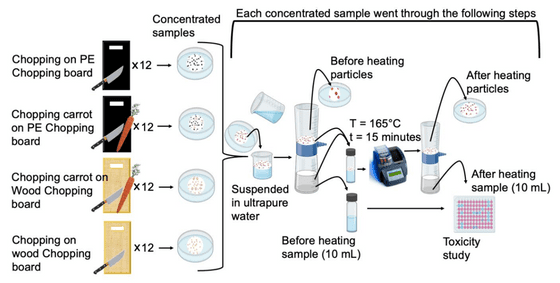Research results that using a plastic cutting board may expose you to ``more than 70 million microplastics per year''

A cutting board is an indispensable tool for everyday cooking, and light and easy-to-use plastic cutting boards are particularly popular. But a new study has found that cutting food with a plastic cutting board can generate a large amount of plastic particles.
Cutting Boards: An Overlooked Source of Microplastics in Human Food? | Environmental Science & Technology
Cutting boards can produce microparticles when chopping veggies, study shows - American Chemical Society
https://www.acs.org/pressroom/presspacs/2023/june/cutting-boards-can-produce-microparticles-when-chopping-veggies.html
Your cutting board might be contaminating your food with microplastics
https://www.zmescience.com/ecology/cutting-board-microplastic/
Your vegetable chopping board is an invisible source of micro-plastics
https://groundreport.in/your-vegetable-chopping-board-is-invisible-source-of-micro-plastics/
When you cut or chop food on a cutting board, it gradually creates grooves and scratches, creating tiny plastic particles that can end up in your food. However, despite the use of cutting boards in households around the world, it has not been confirmed how much microplastics are generated and whether they are harmful.
Therefore, a research team centered on North Dakota State University in the United States conducted an experiment to measure microplastic particles generated in a realistic food cooking scenario. Five volunteers participated in this experiment and cut carrots with steel knives. After cooking, the knives and cutting boards were washed with water that had been tested for plastic particles, and the particles produced by cooking were filtered and analyzed.

Based on the results, the research team estimated that 79.4 million microplastics would be generated annually when cooking with a polypropylene cutting board, and 14.5 million to 71.9 million microplastics per year with a polyethylene cutting board. The most common microplastic particles detected were spherical microplastics less than 100 micrometers in size.
Converting this amount of microplastics to weight, polypropylene cutting boards generate 49.5 g of plastic particles per year, and polyethylene cutting boards generate 7.4 to 50.7 g of plastic particles per year, according to the research team. said.

Experimental results showed that the number of particles generated was affected by how each individual cuts the food and how finely they cut it, but the material of the cutting board had the strongest effect. The research team also conducted experiments with wooden cutting boards, and said that wooden cutting boards released 4 to 22 times more fine particles of wood than plastic cutting boards.
It has been confirmed that the use of cutting boards produces a large amount of fine particles of the material, but the effect on health is unknown. The research team also conducted a toxicity test in which mouse cells were exposed to microplastics and wood particles for 72 hours, but no significant difference was found in this experiment.

Although the short-term preliminary test did not confirm toxicity, the study is positioned as a clear source of microplastics in human food, and the research team has identified plastic cutting boards as a source of microplastics in human food. ``You can reduce potential food microplastic contamination by choosing other options,'' he said about the use of wooden cutting boards.
Related Posts:







